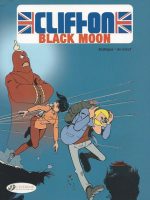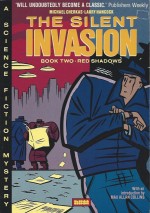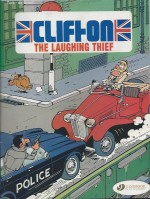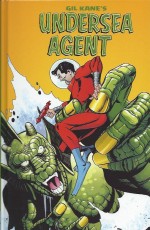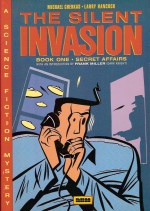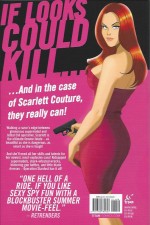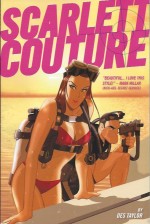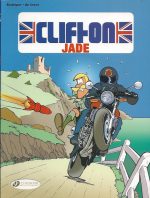
By Rodrigue & de Groot, translated by Luke Spear (Cinebook)
ISBN: 978-1-905460-52-6
An infallible agent of Her Majesty’s assorted security forces, Clifton was created by Raymond Macherot (Chaminou, Les croquillards, Chlorophylle, Sibylline) for the weekly Tintin. Our doughty exemplar of Albion debuted in December 1959, just as a filmic 007 was preparing to set the world ablaze and get everyone hooked on spycraft…
After three albums worth of strip material – all compiled and released in 1959-1960 – Macherot left Tintin for arch-rival Spirou and his bombastic buffoon was benched.
Tintin revived him at the height of the Swinging London scene and aforementioned spy-boom, courtesy of Jo-El Azaza & Greg (Michel Régnier). Those strips were subsequently collected as Les lutins diaboliques in French and De duivelse dwergen for Dutch-speakers in 1969.
Then it was back into retirement until 1971 when – Greg – with artist Joseph Loeckx – took another shot. He toiled on the True Brit until 1973 when Bob De Groot & illustrator Philippe “Turk†Liegeois fully regenerated the be-whiskered wonder. They produced ten more tales after which, from 1984 on, artist Bernard Dumont (AKA Bédu) limned de Groot’s scripts before eventually assuming the writing chores as well. The series concluded in 1995.
…But Never Say Never Again…
In keeping with its rather haphazard Modus Operandi and indomitably undying nature, the Clifton experience resumed yet again in 2003, crafted now by De Groot & Michel Rodrigue for four further adventures. Although the humorous visual vein was still heavily mined in these tales, the emphasis was subtly shifted and the action/adventure components strongly emphasised…
Originally released in 2003, Jade was Rodrigue & De Groot’s first collaboration and signalled a fresh start with all the fans’ favourite bits augmented by a stunning new partner for the old war-horse…
Bob de Groot was born in Brussels in 1941, to French and Dutch parents. As a young man he became art assistant to Maurice Tillieux on Félix, before creating his own short works for Pilote. A rising star in the 1960s, he drew 4 × 8 = 32 L’Agent Caméléon where he met Philippe “Turk†Liegeois, and consequently began making a slow transition from artist to writer. Together they created Archimède, Robin Dubois and Léonard before eventually inheriting Raymond Macherot’s moribund Clifton.
In 1989 de Groot – with Jacques Landrain – devised Digitaline, a strong contender for the first comic created entirely on a computer, and co-created Doggyguard with Michel Rodrigue, even whilst prolifically working with the legendary Morris on both Lucky Luke and its canine comedy spin-off Rantanplan.
He’s still going strong with strips such as Leonard in Eppo, Père Noël & Fils and Le Bar des acariens (both published by Glénat) and much more.
Michel Rodrigue really, really likes Rugby. He was born in Lyon in 1961 and eventually pursued higher education at the National School of Fine Arts, where he also studied medieval archaeology.
From 1983-85 he was part of the French Rugby team and in 1987 designed France’s mascot for the World Cup. He made his comics debut in 1984 with sports (guess which one) strip Mézydugnac in Midi Olympique. After illustrating an adaptation of Edmond Rostand’s Cyrano de Bergerac in 1986 he and collaborator Jean-Claude Vruble produced a volume of La Révolution Française, scripted by Patrick Cothias.
Rodrigue then joined Roger Brunel on Rugby en B.D., Du Monde dans la Coupe!, Concept, Le Rugby en Coupe and La Foot par la Bande.
For Tintin he drew Bom’s Les Conspirateurs and produced Rugbyman, the official monthly of the French Rugby Federation, amongst a welter of other strips. Along the way he began scripting too, and after working with de Groot on Doggyguard joined him on the revived Clifton.
He also remains astonishingly creatively occupied, working on Ly-Noock with André Chéret, Brèves de Rugby, La Grande Trambouille des Fées for René Hausmann, Futurama comics, Cubitus with Pierre Aucaigne, and many more…
Pompous, irascible Colonel Sir Harold Wilberforce Clifton is ex-RAF, a former officer with the Metropolitan Police Constabulary and recently retired from MI5. He has a great deal of difficulty dealing with being put out to pasture in rural Puddington and takes every opportunity to get back in the saddle, assisting the Government or needy individuals as an amateur sleuth whenever the opportunity arises. He occupies his idle hours with as many good deeds as befit a man of his standing and service…
In his revived incarnation the balance between satirical comedy, blistering adventure and sinister intrigue is carefully judged and this re-introductory tale begins with the old soldier and his contentiously fiery, multi-talented housekeeper Mrs. Partridge preparing for a camping trip.
Clifton is taking the local scout troop to Wales, but a few last-minute minor catastrophes are testing his patience and turning the air blue with extremely imaginative invective. The unflappable Mrs. P is able to offset them all – thanks to a family connection in the army surplus business – and soon the Colonel is ready to set off.
Plans change at the very last minute when a shadowy figure leaves a letter. That enigmatic messenger is painfully unaware that it is being carefully observed by another…
The message is in code, but once again la Partridge is up to the task, and Clifton adapts his plans. When the scouts board the lorry the colonel has secured, they learn that they are now heading for Devon…
Arriving at scenic Snooze-on-Pillow, Clifton gets the lads to set up camp but is soon accosted by an unctuous stranger who takes him to meet an old enemy fallen upon ignominious times…
Otto von Kartoffeln was one of Hitler’s greatest assets in the war, but now he is a feeble wreck in an old folks’ home bullied by a monster of a nurse. He doesn’t just want to talk over old times, however. The shrunken old remnant wants to share the secret location of a submarine full of Nazi treasure.
Over tea, served by a rather attractive young lady, the old soldiers’ minds go back to their earliest encounters. The tale unfolds of a U-Boat once commanded by Kartoffeln which sank off Scotland at the end of the war. He would happily have left it there forever, if not for the fact that a gang of neo-Nazis are trying to recover it and start up the Fuhrer’s madness all over again…
The old men have no conception that their teapot is bugged and avid young ears are listening with shock and awe and something else…
All too soon the restless old warrior is hurtling north: dodging bombs and ducking bullets beside an unlikely new partner. Determined on scotching a sinister plot, scuppering a vast submarine base and stopping the rise of the Fourth Reich, Clifton is aware that – as always – there are plots within plots, and amidst the frenetic death-defying action he has to keep one eye on his deadly foes and another on the people claiming to be his allies…
Still, with nothing to lose and civilisation to save, Clifton naturally does his utmost…
Funny, fast and furiously action-packed, Jade gives our Old Soldier a subtle overhaul and fresh start in a cunningly-conceived adventure romp in the grandly daft Get Smart! and Austin Powers manner; sufficient to astound and delight blockbuster addicts whilst supplying a solid line in goofy gags for laughter-addicts of every age to enjoy.
Original edition © Les Editions du Lombard (Dargaud-Lombard SA) 2003 by Rodrigue & De Groot. English translation © 2008 Cinebook Ltd.

